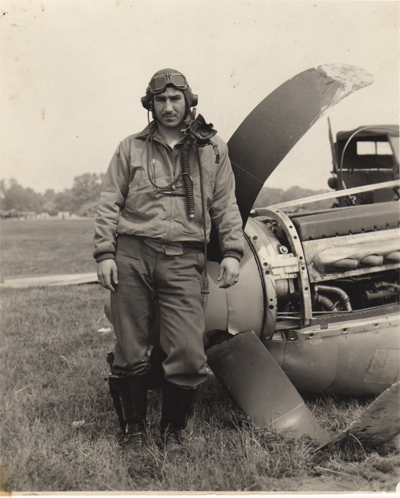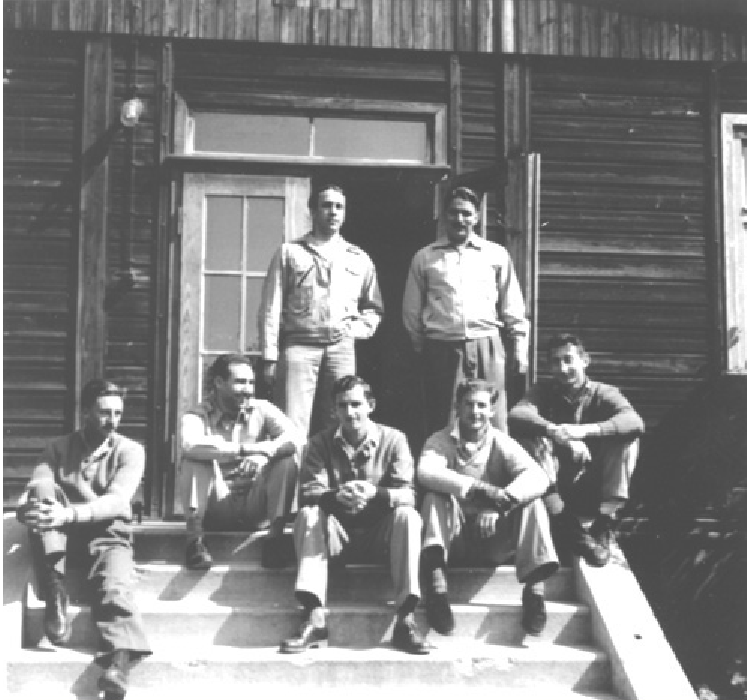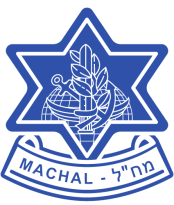
World Machal pays its last salute to Machalnik George Lichter, an outstanding fighter pilot, a superb flying instructor, and an accomplished test pilot.
Born in Brooklyn USA in 1921 to an immigrant family, George signed up for the US Army Air Force pilot training course on the first day following the Japanese attack on Pearl Harbour. He finished his training with distinction, and then as a pilot in the 361 Fighter Group he flew P-51 Mustangs and P-47 Thunderbolts in 88 combat missions over Germany and occupied Europe. George returned home at the end of 1944 as a decorated war hero.
When 6 Arab Armies attacked Israel on 15th May 1948, George threw in his lot with his fellow-Jews. He volunteered to fly in a then non-existent Israel Air Force (IAF). In the first stage in the process he landed-up in Czechoslovakia with a group of other volunteer ex-World War II pilots, mainly from the USA, South Africa, Britain and Canada.

Ceske Budejovice, June 1948
Standing left to right; Chris McGee and Syd Cohen
Lower row left to right: Boris Senior, George Lichter, Les Shagam,
Arnie Ruch, Rudi Augarten
(Photo: 101 Squadron)
Israel had just acquired its very first combat aircraft – 25 Czech-built Avia S-199s (known as the Czech “Messerschmitts”). These aircraft were modeled on the famous German ME-109 fighter aircraft, but had been cobbled together with ill-fitting German aerial engines, air frames, landing gears, etc., which resulted in a devilishly dangerous aircraft to fly. Even the Czech instructors who had undertaken to train the IAF pilots had the utmost difficulty in flying these aircraft, but the one pilot who mastered the art of flying this dangerous and awkward aircraft was George Lichter. George had become so proficient in flying the Messerschmitts that he took over the pilot training program. It should also be mentioned that the Machal pilots were living under the most austere conditions concerning food and accommodation.
In August 1948 Israel acquired 50 Spitfires from Czechoslovakia. In defiance of a United Nation’s arms embargo on the export of military equipment to Israel, an air bridge had been established between Czechoslovakia and Tel Nof Air Base, which was Israel’s only line of communication with the outside world. However, due to pressure from the US and Britain, Czechoslovakia was forced to terminate this air bridge at the very time that the Spitfires were sold to Israel. As a result of this devastating blow the Spitfires could not be transported but had to be flown to Israel, a distance of 1,900 miles (3,000 kilometres), which meant that the flying endurance of a fully-laden Spitfire had to be increased from about 1.5 hours to 6 hours. Due to the ingenuity and improvisation of Sam Pomerance, an outstanding Machal pilot and aviation engineer, the fuel capacity of the Spitfires was increased from 85 to 379 gallons, but at the cost of stripping the Spitfires of their armor plating, guns, cannons, radios, oxygen cylinders, cameras, and navigation equipment, and then attaching fuel tanks under the belly and under the wings of the aircraft, and even inside the cockpit. Once again, George’s skill and talent came to the fore. George and his fellow South African Machalnik Jack Cohen successfully test-flew all 50 Spitfires in their new configuration.
A formation of 12 Spitfires took off from Czechoslovakia to Israel in mid-December under very adverse weather conditions. In this formation, George led a section with two semi-trained Israeli pilots – Motti Hod and Danny Shapiro. Notwithstanding that these two trainee pilots had less than 7 hours of flying experience on Spitfires, George decided to take the risk of including them in this 6-hour epic flight. Danny reports that when he lost his place in his formation in very dense cloud and became totally disorientated, he was just about to bale out. When George realized that Danny was missing he was determined to find him which he did at the 59th minute, and Danny asserts with deep emotion that he owes his life to George.
On arriving in Israel George joined 101 Squadron, Israel’s first combat squadron which had become a formidable fighting force manned by experienced World War II veteran pilots. The fighting phase of the War of Independence ended on 7th January 1949 on a highly dramatic and spectacular note when the Israel Air Force shot down 5 Royal Air Force fighters which had intruded into the battle area – 4 Spitfires and 1 Tempest, and damaging 3 other Tempests.
After the war ended most of the Machal pilots, including George, returned to their home countries, but after a short while Israel’s magnetism drew George back to the Air Force. He was appointed Chief Test Pilot at Tel Nof Air Base, and his next assignment was as Chief Instructor at the IAF’s Advanced Flying School. It must have given George deep satisfaction and gratification when the first four Israeli pilots were awarded their wings on 14th March 1949 – Motti Hod, Danny Shapiro, Tibby Ben-Shachar, and Shaya Gazit. Motti Hod subsequently became Chief of the Israeli Air Force and was in command of the IAF in the 6-Day War in which the Air Force achieved its spectacular victories over the Egyptian, Syrian, and Jordanian Air Forces. Danny Shapiro went on to become a renowned and legendary test pilot. Tibby Ben-Shachar became the Chief Pilot of Arkia Airlines, and Shaya Gazit had a splendid record of service in the IAF.
George Lichter passed away on 2nd August 2013, and he most certainly earned a well-deserved place in the pantheon of the Israel Air Force.
Source: This article was prepared by Smoky Simon, Chairman, World Machal.

